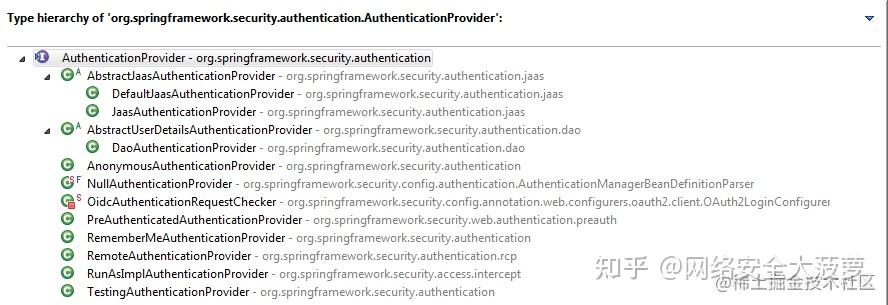SpringBoot + Spring Security 学习笔记(二)安全认证流程源码详解
用户认证流程
UsernamePasswordAuthenticationFilter
我们直接来看
UsernamePasswordAuthenticationFilter
类,
public class UsernamePasswordAuthenticationFilter extends
AbstractAuthenticationProcessingFilter {public Authentication attemptAuthentication(HttpServletRequest request,HttpServletResponse response) throws AuthenticationException {// 判断是否是 POST 请求if (postOnly && !request.getMethod().equals("POST")) {throw new AuthenticationServiceException("Authentication method not supported: " + request.getMethod());}// 获取请求中的用户,密码。// 就是最简单的:request.getParameter(xxx)String username = obtainUsername(request);String password = obtainPassword(request);if (username == null) {username = "";}if (password == null) {password = "";}username = username.trim();// 生成 authRequest,本质就是个 usernamePasswordAuthenticationTokenUsernamePasswordAuthenticationToken authRequest = new UsernamePasswordAuthenticationToken(username, password);// 把 request 请求也一同塞进 token 里// Allow subclasses to set the "details" propertysetDetails(request, authRequest);// 将 authRequest 塞进 AuthenticationManager并返回return this.getAuthenticationManager().authenticate(authRequest);}
}
在
attemptAuthentication()
方法中:主要是先进行请求判断并获取
username
和
password
的值,然后再生成一个
UsernamePasswordAuthenticationToken
对象,将这个对象塞进
AuthenticationManager
对象并返回,注意:
此时的
authRequest
的权限是没有任何值的
。
UsernamePasswordAuthenticationToken
不过我们可以先看看
UsernamePasswordAuthenticationToken
的构造方法:
public UsernamePasswordAuthenticationToken(Object principal, Object credentials) {super(null);this.principal = principal;this.credentials = credentials;setAuthenticated(false);
}
其实
UsernamePasswordAuthenticationToken
是继承于
Authentication
,该对象在学习笔记一中的中"自定义处理登录成功/失败"章节里的自定义登录成功里有提到过,它是处理登录成功回调方法中的一个参数,里面包含了用户信息、请求信息等参数。

来一张继承关系图,对其有个大概的认识,注意到
Authentication
继承了
Principal
。
AuthenticationManager
AuthenticationManager
是一个接口,它的所有实现类如图:

其中一个十分核心的类就是:
ProviderManager
,在
attemptAuthentication()
方法最后返回的就是这个类
this.getAuthenticationManager().authenticate(authRequest);
进入
authenticate()
方法查看具体做了什么:
public Authentication authenticate(Authentication authentication)
throws AuthenticationException {Class<? extends Authentication> toTest = authentication.getClass();AuthenticationException lastException = null;AuthenticationException parentException = null;Authentication result = null;Authentication parentResult = null;boolean debug = logger.isDebugEnabled();for (AuthenticationProvider provider : getProviders()) {// 1.判断是否有provider支持该Authenticationif (!provider.supports(toTest)) {continue;}if (debug) {logger.debug("Authentication attempt using " + provider.getClass().getName());}try {// 2. 真正的逻辑判断result = provider.authenticate(authentication);if (result != null) {copyDetails(authentication, result);break;}}catch (AccountStatusException e) { ……}}……
}
这里首先通过 provider 判断是否支持当前传入进来的
Authentication
,目前我们使用的是
UsernamePasswordAuthenticationToken
,因为除了帐号密码登录的方式,还会有其他的方式,比如
JwtAuthenticationToken
。
从整体来看
Authentication
的实现类如图:

官方 API 文档 列出了所有的子类

从整体来看
AuthenticationProvider
的实现类如图:

官方 API 文档 列出了所有的子类

根据我们目前所使用的
UsernamePasswordAuthenticationToken
,provider 对应的是
AbstractUserDetailsAuthenticationProvider
抽象类的子类
DaoAuthenticationProvider
,其
authenticate()
属于抽象类本身的方法。
public Authentication authenticate(Authentication authentication)
throws AuthenticationException {Assert.isInstanceOf(UsernamePasswordAuthenticationToken.class, authentication, () -> messages.getMessage("AbstractUserDetailsAuthenticationProvider.onlySupports","Only UsernamePasswordAuthenticationToken is supported"));// Determine usernameString username = (authentication.getPrincipal() == null) ? "NONE_PROVIDED": authentication.getName();boolean cacheWasUsed = true;// 1.从缓存中获取 UserDetailsUserDetails user = this.userCache.getUserFromCache(username);if (user == null) {cacheWasUsed = false;try {// 2.缓存获取不到,就去接口实现类中获取user = retrieveUser(username,(UsernamePasswordAuthenticationToken) authentication);}catch (UsernameNotFoundException notFound) {……}Assert.notNull(user, "retrieveUser returned null - a violation of the interface contract");}try {// 3.用户信息预检查(用户是否密码过期,用户信息被删除等)preAuthenticationChecks.check(user);// 4.附加的检查(密码检查:匹配用户的密码和服务器中的用户密码是否一致)additionalAuthenticationChecks(user, (UsernamePasswordAuthenticationToken) authentication);}catch (AuthenticationException exception) {if (cacheWasUsed) {// There was a problem, so try again after checking// we're using latest data (i.e. not from the cache)cacheWasUsed = false;user = retrieveUser(username,(UsernamePasswordAuthenticationToken) authentication);preAuthenticationChecks.check(user);additionalAuthenticationChecks(user, (UsernamePasswordAuthenticationToken) authentication);}else {throw exception;}}// 5.最后的检查postAuthenticationChecks.check(user);……// 6.返回真正的经过认证的Authentication return createSuccessAuthentication(principalToReturn, authentication, user);
}
注意:
retrieveUser()
的具体方法实现是由
DaoAuthenticationProvider
类完成的:
public class DaoAuthenticationProvider extends AbstractUserDetailsAuthenticationProvider {
protected final UserDetails retrieveUser(String username,UsernamePasswordAuthenticationToken authentication)throws AuthenticationException {prepareTimingAttackProtection();try {// 获取用户信息UserDetails loadedUser = this.getUserDetailsService().loadUserByUsername(username);if (loadedUser == null) {throw new InternalAuthenticationServiceException("UserDetailsService returned null, which is an interface contract violation");}return loadedUser;}catch (UsernameNotFoundException ex) {……}}
}
同时
createSuccessAuthentication()
的方法也是由
DaoAuthenticationProvider
类来完成的:
// 子类拿 user 对象
@Override
protected Authentication createSuccessAuthentication(Object principal, Authentication authentication, UserDetails user) {boolean upgradeEncoding = this.userDetailsPasswordService != null&& this.passwordEncoder.upgradeEncoding(user.getPassword());if (upgradeEncoding) {String presentedPassword = authentication.getCredentials().toString();String newPassword = this.passwordEncoder.encode(presentedPassword);user = this.userDetailsPasswordService.updatePassword(user, newPassword);}// 调用父类的方法完成 Authentication 的创建return super.createSuccessAuthentication(principal, authentication, user);
// 创建已认证的 Authentication
protected Authentication createSuccessAuthentication(Object principal,
Authentication authentication, UserDetails user) {UsernamePasswordAuthenticationToken result = new UsernamePasswordAuthenticationToken(principal, authentication.getCredentials(),authoritiesMapper.mapAuthorities(user.getAuthorities()));result.setDetails(authentication.getDetails());return result;
}
小结:
authenticate()
的认证逻辑
1.去调用自己实现的
UserDetailsService
,返回
UserDetails
2.对 UserDetails 的信息进行校验,主要是帐号是否被冻结,是否过期等 3.对密码进行检查,这里调用了
PasswordEncoder
,检查 UserDetails 是否可用。 4.返回经过认证的
Authentication
编码技巧提示:这里在认证之前使用了Assert.isInstanceOf()进行断言校验,方法内部也不断用了Assert.notNull(),这种编码非常的灵巧,省去了后续的类型判断。
这里的两次对
UserDetails
的检查,主要就是通过它的四个返回 boolean 类型的方法(
isAccountNonExpired()
,
isAccountNonLocked()
,
isCredentialsNonExpired()
,
isEnabled()
)。
经过信息的校验之后,通过
UsernamePasswordAuthenticationToken
的全参构造方法,返回了一个已经过认证的
Authentication
。
拿到经过认证的
Authentication
之后,至此
UsernamePasswordAuthenticationFilter
的过滤步骤就完全结束了,之后就会进入
BasicAuthenticationFilter
,具体来说就是去调用
successHandler
。或者未通过认证,去调用
failureHandler
。
已认证数据共享
完成了用户认证处理流程之后,我们思考一下是如何在多个请求之间共享这个认证结果的呢?因为没有做关于这方面的配置,所以可以联想到默认的方式应该是在session中存入了认证结果。思考:那么是什么时候存放入session中的呢?
认证流程完毕之后,再看是谁调用的它,发现是
AbstractAuthenticationProcessingFilter
的
doFilter()
进行调用的,这是
AbstractAuthenticationProcessingFilter
继承关系结构图:

当认证成功之后会调用
successfulAuthentication(request, response, chain, authResult)
,该方法中,不仅调用了
successHandler
,还有一行比较重要的代码:
public abstract class AbstractAuthenticationProcessingFilter extends GenericFilterBean
implements ApplicationEventPublisherAware, MessageSourceAware {public void doFilter(ServletRequest req, ServletResponse res, FilterChain chain)throws IOException, ServletException {// 调用了 UsernamePasswordAuthenticationFilterauthResult = attemptAuthentication(request, response);……// 调用方法,目的是保存到session successfulAuthentication(request, response, chain, authResult);}// 将成功认证的用户信息保存到sessionprotected void successfulAuthentication(HttpServletRequest request,HttpServletResponse response, FilterChain chain, Authentication authResult)throws IOException, ServletException {if (logger.isDebugEnabled()) {logger.debug("Authentication success. Updating SecurityContextHolder to contain: " + authResult);}// 保存到 SecurityContextHolder 的静态属性 SecurityContextHolderStrategy 里, 非常重要的代码SecurityContextHolder.getContext().setAuthentication(authResult);rememberMeServices.loginSuccess(request, response, authResult);// Fire eventif (this.eventPublisher != null) {eventPublisher.publishEvent(new InteractiveAuthenticationSuccessEvent(authResult, this.getClass()));}successHandler.onAuthenticationSuccess(request, response, authResult);}
// SecurityContextHolder类中存着 静态属性:SecurityContextHolderStrategy
public class SecurityContextHolder {……private static SecurityContextHolderStrategy strategy;……public static void setContext(SecurityContext context) {strategy.setContext(context);}
}
SecurityContextHolderStrategy
接口的所有实现类:

非常显眼的看出:
ThreadLocalSecurityContextHolderStrategy
类:
final class ThreadLocalSecurityContextHolderStrategy implements
SecurityContextHolderStrategy {private static final ThreadLocal<SecurityContext> contextHolder = new ThreadLocal<>();……public void setContext(SecurityContext context) {Assert.notNull(context, "Only non-null SecurityContext instances are permitted");// 将已认证的用户对象保存到 ThreadLocal<SecurityContext> 中contextHolder.set(context);}……
}注意:SecurityContext类的equals()和hashCode()方法已经重写了,用来保证了authentication的唯一性。
身份认证成功后,最后在
UsernamePasswordAuthenticationFilter
返回后会进入一个
AbstractAuthenticationProcessingFilter
类中调用
successfulAuthentication()
方法,这个方法最后会返回我们自己定义的登录成功处理器
handler
。
在返回之前,它会调用
SecurityContext
,最后将认证的结果放入
SecurityContextHolder
中,SecurityContext 类很简单,重写了
equals()
方法和
hashCode()
方法,保证了authentication的唯一性。
从代码可以看出:
SecurityContextHolder
类实际上是对
ThreadLocal
的一个封装,可以在不同方法之间进行通信,可以简单理解为线程级别的一个全局变量。
因此,可以在同一个线程中的不同方法中获取到认证信息。最后会被
SecurityContextPersistenceFilter
过滤器使用,这个过滤器的作用是:
当一个请求来的时候,它会将 session 中的值传入到该线程中,当请求返回的时候,它会判断该请求线程是否有
SecurityContext
,如果有它会将其放入到 session 中,因此保证了请求结果可以在不同的请求之间共享。
用户认证流程总结
引用徐靖峰在个人博客 Spring Security(一)--Architecture Overview 中的概括性总结,非常的到位:
1.用户名和密码被过滤器获取到,封装成
Authentication
,通常情况下是
UsernamePasswordAuthenticationToken
这个实现类。 2.
AuthenticationManager
身份管理器负责验证这个
Authentication
。 3.认证成功后,
AuthenticationManager
身份管理器返回一个被填充满了信息的(包括上面提到的权限信息,身份信息,细节信息,但密码通常会被移除)
Authentication
实例。 4.
SecurityContextHolder
安全上下文容器将第3步填充了信息的
Authentication
,通过
SecurityContextHolder.getContext().setAuthentication(…)
方法,设置到其中。
高度概括起来本章节所有用的核心认证相关接口:
SecurityContextHolder
是
身份信息的存放容器,
Authentication
是身份信息的抽象,
AuthenticationManager
是身份认证器,一般常用的是用户名+密码的身份认证器,还有其它认证器,如邮箱+密码、手机号码+密码等。
再引用一张十分流行的流程图来表示用户的认证过程:

架构概览图
为了更加形象的理解,在徐靖峰大佬的经典架构图之上,根据自己的理解,做了更多的细化和调整:

获取认证用户信息
如果我们需要获取用的校验过的所有信息,该如何获取呢?上面我们知道了会将校验结果放入 session 中,因此,我们可以通过 session 获取:
@GetMapping("/me1")
@ResponseBody
public Object getMeDetail() {return SecurityContextHolder.getContext().getAuthentication();
@GetMapping("/me2")
